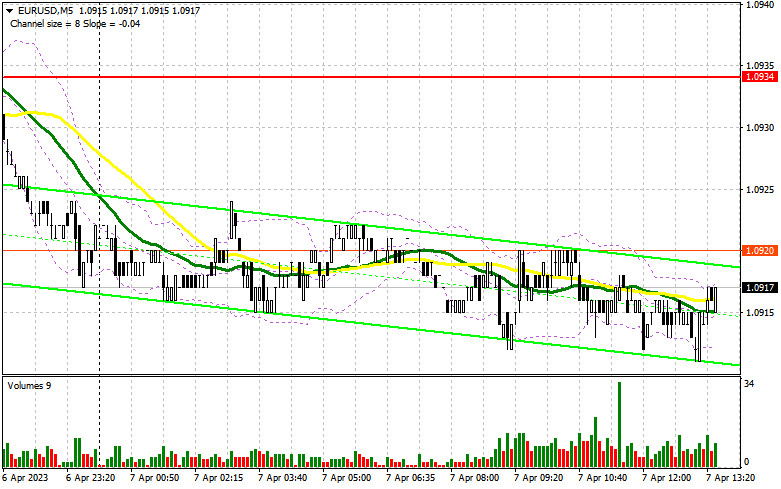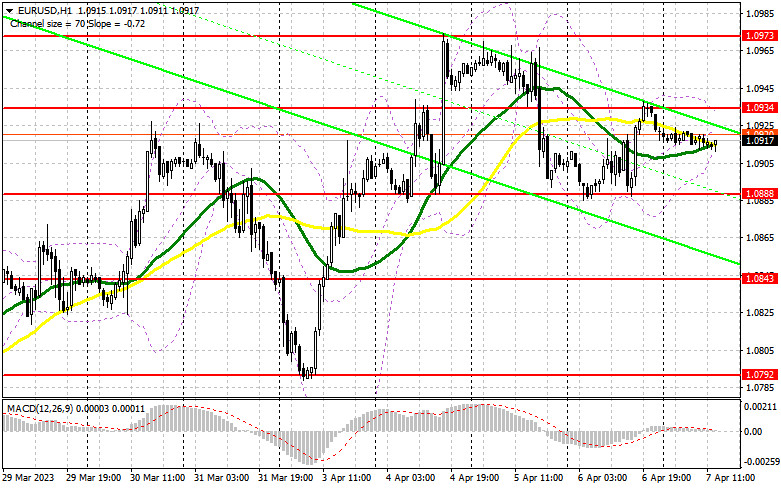
In my morning forecast, I called attention to the level of 1.0934 and recommended making decisions on market entry from there. Let's look at the 5-minute chart and figure out what happened there. A false breakout at this level did not occur due to low market volatility. The technical picture for the second half of the day has stayed the same, and the strategy itself has stayed the same.

To open long positions on EUR/USD:
Considering nothing was special in the first half of the day, the market demonstrated the same volatility. Now, the focus is on the US unemployment rate and changes in the number of non-agricultural sector employees for March this year. Nothing extraordinary will happen. The data will likely be worse than February's and even worse than economists' forecasts. This, in theory, should help the euro and weaken the dollar's position, but only some things in the market happen as expected. Therefore, after a small surge in volatility and an upward movement of the euro, I bet on the pair's decline by the end of the day. Since the technical picture hasn't changed, the best way to open long positions is still for the price to go down and a false breakout around the lower boundary of the sideways channel at 1.0888. This will signal a buy with a target of returning to the resistance level of 1.0934, formed based on yesterday's results. A breakthrough and a top-down test of this range will return the market to the buyers' side, creating an additional entry point for increasing long positions with a return to the monthly maximum at 1.0973. The furthest target remains the 1.1002 area, where I will fix the profit. In the case of a decline in EUR/USD and a lack of buyers at 1.0888 in the second half of the day, which may happen if the US data turns out to be better than economists' forecasts and the labor market shows strength, the pressure on the euro will increase. We will see a downward movement to 1.0843. Only the formation of a false breakout will signal a euro purchase. I will open long positions immediately on the rebound from the minimum of 1.0792 with the aim of an upward correction of 30-35 points within the day.
To open short positions on EUR/USD:
For sellers, nothing has changed: the important task is to protect the nearest resistance at 1.0934, formed based on yesterday's results. Slightly below this level, the moving averages pass, playing on the bears' side. From 1.0921, I expect to see large players, so the optimal scenario for opening new short positions will be the formation of a false breakout there. Strong data on the US labor market will pressure the euro, leading to a decline in the pair around the nearest support at 1.0888. A breakthrough and a reverse test of this range will further increase pressure, pushing the pair to 1.0843. Fixing below this range will open the way to 1.0792, returning the bearish trend to the market. I will fix the profit there. In case of an upward movement of EUR/USD during the American session and a lack of bears at 1.0934, which is also quite a realistic scenario, I advise postponing short positions to the level of 1.0973. You can only sell after an unsuccessful consolidation. I will open short positions immediately on the rebound from the maximum of 1.1002 with the aim of a downward correction of 30 to 35 points.

In the COT report (Commitment of Traders) for March 28, an increase in both long and short positions was recorded. Considering that nothing interesting happened last week and that the data on the US personal consumption expenditure price index turned out to be not as good as economists expected, it is likely that the Federal Reserve will raise rates again at the next meeting. However, an aggressively minded European Central Bank, which will most likely continue to raise interest rates further and more actively, allows buyers of the European currency to act more actively on every significant decline in the euro against the dollar. Apart from the US unemployment data, something needs to be more interesting this week so the euro has every chance to update its March highs. The COT report indicates that long non-commercial positions increased by 7,093 to 222,918, while short non-commercial positions jumped by 6,910 to 77,893. As a result of the week, the total non-commercial net position increased to 145,025 from 144,842. The weekly closing price increased to 1.0896 from 1.0821.
Indicator signals:
Moving averages
Trading occurs slightly below the 30- and 50-day moving averages, indicating a sideways market character.
Note: The author considers the period and prices of moving averages on an hourly H1 chart and differs from the general definition of classic daily moving averages on a daily D1 chart.
Bollinger Bands
In cases of growth, the upper border of the indicator at 1.0934 will act as resistance.
Description of indicators
• Moving average (determines the current trend by smoothing volatility and noise). Period 50. Marked in yellow on the chart.
• Moving average (determines the current trend by smoothing volatility and noise). Period 30. Marked in green on the chart.
• MACD indicator (Moving Average Convergence/Divergence - convergence/divergence of moving averages) Fast EMA period 12. Slow EMA period 26. SMA period 9
• Bollinger Bands. Period 20
• Non-commercial traders - speculators, such as individual traders, hedge funds, and large institutions, using the futures market for speculative purposes and meeting certain requirements.
• Long non-commercial positions represent the total long open position of non-commercial traders.
• Short non-commercial positions represent the total short open position of non-commercial traders.
• The total non-commercial net position is the difference between the short and long positions of non-commercial traders.